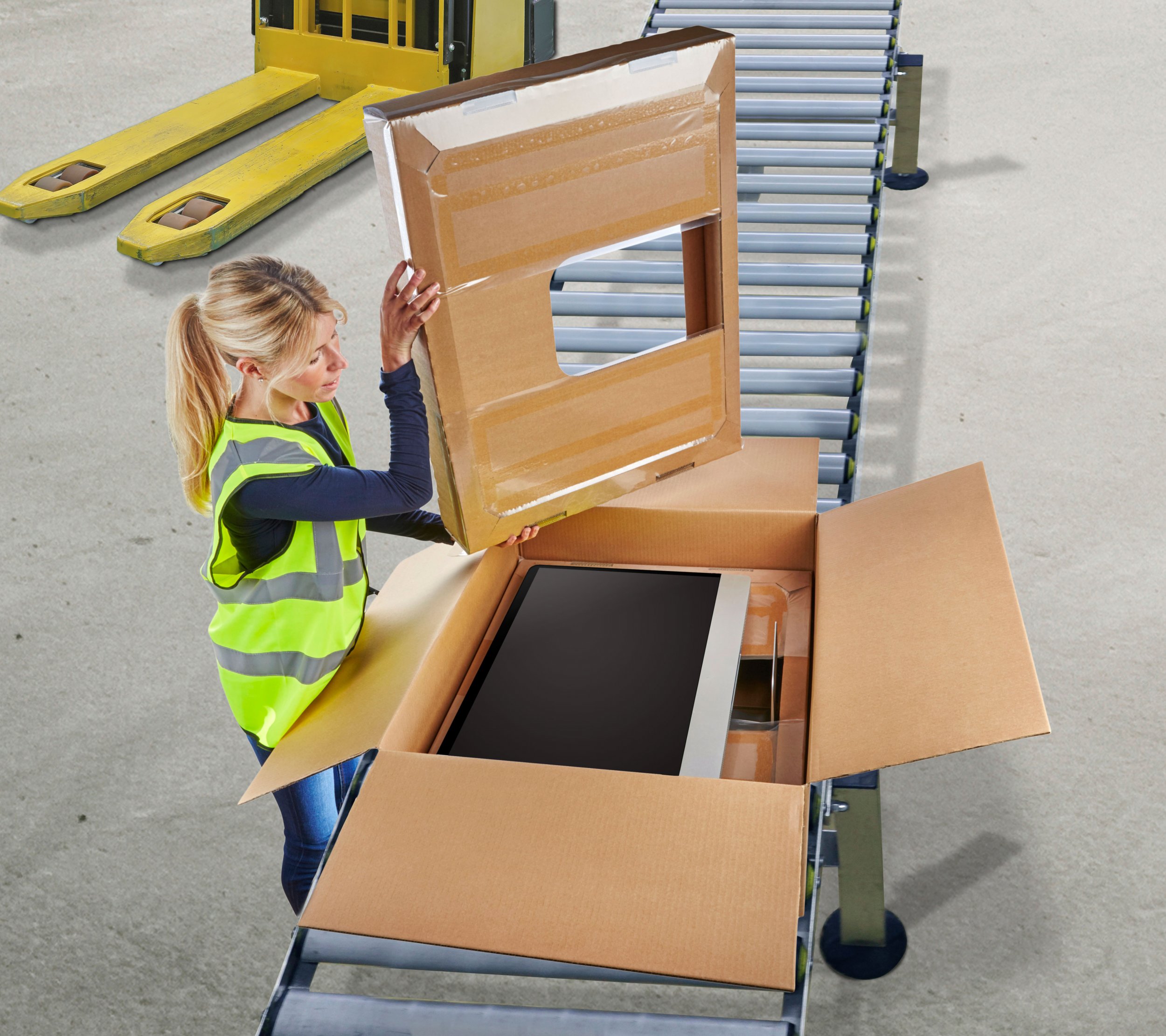
Sixty years ago, a couple of engineers set out to create a new kind of wallpaper, sealing together two plastic shower curtains with air bubbles trapped in between. The idea was a flop, so they peddled their new product as greenhouse insulation. That tanked, too. In 1960, the two men, Alfred Fielding and Marc Chavannes, founded Sealed Air Corporation. Their unimpressive little invention finally had its moment as their flagship product: Bubble Wrap.
Today, Sealed Air's products are pretty much everywhere—in Amazon boxes, lining mail-order meal-prep kits, shipping meat around the country, and helping hurricane victims across the southeast. With a new global headquarters in Charlotte, North Carolina, the company has 14,000 employees in 117 countries. Sustainability is at the heart of Sealed Air's work. Newsweek spoke with vice president of sustainability, Ron Cotterman, who joined the company 32 years ago and became its first sustainability employee in 2007.
This interview has been edited for length and clarity.
What are some of the most innovative and environmentally friendly packing products you've created?
We look at sustainability in a context of what we do rather than what we sell. Let me give you an example: Look at the amount of food wasted on a global basis. A large fraction of food produced is not consumed, for a variety of reasons, but certainly in the U.S., consumers are a big source of waste. We provide solutions to help the entire value chain, all the way from food processors to retailers to restaurants to consumers, to try to prevent the waste that they encounter in their food consumption pattern.
As an example, we sell packaging with a lot of functionality to it. Fresh meat may spoil in a couple days if it's under-packaged, but we get two to three weeks more of freshness. The ability to extend the shelf life of food so it doesn't spoil gives everybody across that supply chain more time to distribute it, sell it and use it in your kitchen, and it's all because of the way that the food is protected after it's produced.

Cyber Monday was just last week, and with the holiday season coming up, countless boxes are shipping out across the country. How do you strive to make e-commerce more sustainable?
How many times do you get a box at your doorstep and say, 'That thing is huge. All I ordered was this small item!' From a sustainability perspective, the amount of resources used to enable that e-commerce change are enormous. We're a packaging company, so how do you make things smaller without damaging them, and still ensuring fast delivery and quick fulfillment rates?
An example is flat screen TVs. Before last year, if you wanted one, you'd go to Costco or Best Buy and look at floor models, then roll one out the front of the store and take it home. Last year, people started ordering flat screen TVs on the Internet. There was a tremendous amount of damage, because the boxes used to package those TVs were never intended to be shipped by mail. We got the phone call, because we're the Bubble Wrap company, of course!
We put in place a temporary solution for retailers. Before TVs went onto the trucks, the boxes were protected. You put a box in a box. That solved a major problem, which was, you don't want to get a damaged TV. Now, we're working back all the way to the source of the packaging, which many times is in Asia, and we're changing the packaging that goes through that supply chain so it works for the e-commerce supply chain.
As you just said, "We're the Bubble Wrap company!" How does your signature product fit in with your sustainability goals today?
When you think about packaging, it's hard to imagine another form as fun as Bubble Wrap. People have an emotional connection to it—it's a toy, a stress reliever. But Bubble Wrap is really useful because of something it does functionally: It cushions and protects. We want to preserve that. But it has another challenge: It's so darn lightweight, that when you ship it around, you use lots of trucks to ship air.
Now, Bubble Wrap doesn't have to go full of air in the box. You can inflate it on-site. That's an innovation we started a couple years ago, shipping a product called NewAir IB®. It's a sustainability story. Instead of the 47 trucks bringing that Bubble Wrap to that fulfillment center, now you need one truck.
What about the pillow-like packaging that fills up the space in big boxes when they contain a small item? Isn't that a waste?
Boxes used to be [filled with] peanuts. We came in with what's called void fill, which is a very effective way of filling up space in a box. The question is, why do you have so much void in the first place? Those pillows don't cushion; they just fill the space. We've got packaging now, called I-Pack, where you fold the box to just the right size. If you order one book that fills up a fifth of a box, you don't need that box. You fold it in the right size to ship that one article. That's the second class of innovation: Get rid of that void. Why have that big box in the first place? It's because companies that fulfill those orders don't want to stock a lot of different sizes of boxes. Now we're saying, you don't need to stock different sizes, you just stock I-Pack.
And one more thing—you're gonna love this one! If you're ordering something that already has a nice box, why put it in another box at all? We now have a brand new thing we launched earlier this year, StealthWrap. It's a thin piece of film. You can ship that box to your doorstep with film instead of a box. We've gone all the way from Bubble Wrap inflating on site, to getting rid of the void by using right-size-boxes, to getting rid of the box using StealthWrap. It's a whole evolution.

Can you give me an example of how your packaging and products help needy populations?
In a macro sense, we deliver nutrition around the world every day. When the typhoon hit the Philippines in 2013, we partnered with customers and shipped rolls of film that could be run on a machine and filled with water, so that we could supply water pouches.
I can take any plastic scrap or waste and turn it into other stuff—into these 'films.' In a disaster, that's in high demand. Stretching a tarp over a roof that's damaged, or providing dividers for privacy at a center with families. We ship a lot of that film into areas used for that disaster relief. This is stuff that in other circumstances would be in a landfill, and here we've repurposed it in ways to bring intangible benefits.
How much of a focus is sustainability and green efforts at the company?
We are greener than green! Sustainability has a great business case. If you can solve big problems that have an environmental impact, they often have a financial benefit as well. We've adopted this. We talk about sustainability that aligns around the concept of resources: natural resources (like energy and water), physical resources (infrastructure, road systems, the electrical grid), and human resources (labor). We try to hit all those resource challenges. How do we make materials flow through supply chains more effectively? How to bring automation into facilities? Dealing with workers and quality issues are important, too.
What innovations should we be looking out for in the future?
We're very focused on environmental impact, not only of our solutions but our supply chain. We are looking at the greenhouse gas emissions, and the goals our customers have set, and how can we help them reduce that, and aligning with the Paris Agreement. These are part of today's world that we're participating in. In the future, it's really about that interface with automation and labor. We want certain things—food or goods delivered—but we can't continue to use the same natural, physical or labor resources to deliver those items. So we've gotta change the way we look at things and the way information flows.
Uncommon Knowledge
Newsweek is committed to challenging conventional wisdom and finding connections in the search for common ground.
Newsweek is committed to challenging conventional wisdom and finding connections in the search for common ground.
About the writer
Abigail Jones is an award-winning journalist and New York Times bestselling author. Her Newsweek cover story, “Life After Eleven Years ... Read more
To read how Newsweek uses AI as a newsroom tool, Click here.






